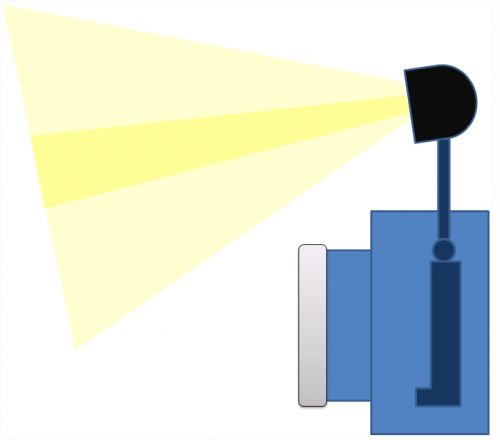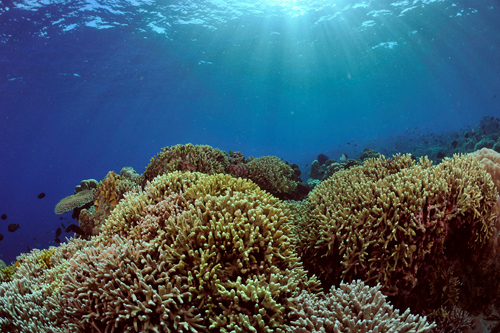Underwater Strobe Positioning
Basic Strobe Techniques
While photography is very subjective and there are an unlimited number of ways to get creative with your lighting, there are a few basic rules that you should follow to build the base of your technique in order to recreate and even transcend the colorful splendor of your dives.
Strobe Positioning
Whether you shoot with one strobe or two, the positioning of your strobes plays a vitally important role in the quality of your underwater lighting. By placing your strobes on articulated arms that are extended away from your camera, you will achieve even and soft lighting with limited shadows. This positioning is also required to reduce the illumination of particles in the water column, otherwise known as “backscatter”. In all instances diffusers will help widen the angle of coverage and reduce hot spots in your images.

If you have only one strobe, positioning is crucial and there are several approaches depending on what you are shooting. Start with your strobe positioned out to the side and above your camera at a 45 degree angle. Keep in mind that this will create lighting from one specific angle, and thus shadows on the reverse side. Move your strobe to different positions, including above the camera and subject and look at the results in your LCD screen. The key is not to get stuck in one position. The angle of your light source makes a big difference. For macro, you may find that positioning the strobe above your camera and subject works best to prevent harsh directional shadows, particularly since you are usually shooting a subject that is sitting on the image background.

Shooting with two strobes gives you the flexibility to utilize one strobe as your key (main) light and the other a fill light, or use both strobes to evenly light a scene with soft flattering light and minimal shadows. The latter is certainly an easier choice, and common among most underwater photographers, but generally produces flat images that lack the kind of dimension that is possible if you take the time to experiment and be creative with your strobe positioning and variable power settings. Don’t forget that the ambient light (the sun) also provides fill light, but does not make colors pop or accentuate details in the shadows that your strobes can achieve.
Sidelighting, Toplighting, Backlighting
By deviating from the “traditional” front lighting positioning, you will open up a world of creative opportunity. Some ideas include.
-
Sidelighting: creates texture and dimension, emphasizes certain features of the subject
-
Toplighting: creates the effect of uni-directional lighting, prevents the illumination of parts of the foreground that you may wish to leave unlit.
-
Backlighting: creates a dramatic and unique effect of glowing edges around a silhouetted subject, can make translucent subjects appear to glow from within. (see advanced lighting techniques)
Tricky Lighting Situations
The trickiest lighting scenarios you will encounter include:
-
Reflective surfaces such as silver fish (barracudas, tarpon, etc.)
The best approach to shooting reflective fish is to angle your strobes out a bit and shoot at an angle where the reflection of your strobes won’t return back in the direction of your camera. Remember your high school geometry class - the angle of reflection equals angle of incidence.

-
High contrast between subject and background
When shooting a dark subject against a bright background, you must light the foreground with a significant amount of strobe light, yet meter your camera settings to not overexpose the background or adjacent foreground (like white sand for example). Often you may opt to chimp your camera settings to balance good ambient fill and use your strobe to open up the shadows and details without blasting the subject at full power.

Black subjects are notoriously difficult to light, particularly while balancing strong levels of ambient light. Acheiving detail in this black frogfish while not over exposing the coral around him was impossible. This is about as good as it gets, and was all due to proper strobe positioning and a lot of patience. -
High dynamic range
In all of these instances, the issue is overexposing elements of the frame to the extent of being “blown out” also referred to as “clipping the highlights”. Technically this is data that falls outside the maximum range of processing by your camera’s digital sensor. For all practical purposes, you cannot recover detail in areas that are blown out, so you are best to avoid it.

In order to light and detail the inside of this shipwreck, a sacrifice was made by blowing out the sun. While still marginally acceptable in this instance, it is best to avoid blowing out highlights, which becomes very distracting in an image. Ideally, getting down a little lower and positioning the sun behind the shipwreck would have been a solution, but in this instance was impossible due to sharp metal protusions inside the wreck.
Beyond the basic or traditional approaches to lighting, you may also want to experiment with side lighting, top lighting or back lighting, which we talk about in advanced lighting techniques.
Strobe to Subject Distance
Like natural light itself, the light emitted by your strobes also gets absorbed by the water. Always try to get close to your subject as possible. When you think you are close enough, get closer! Keep in mind that the light from your strobes actually travels twice the distance between you and your subject by the time it completes its round trip and enters your camera. Even the most powerful strobes are not able to illuminate subjects beyond a few feet or so. Large scenes such as an entire reef are impossible to light completely, but rather you must be strategically positioned to light a portion of an interesting foreground, which will create contrast against the ambient exposed background. Balancing the artificial strobe light in the foreground with the ambient light in the background is an important skill to learn if you want to shoot wide angle successfully.


Inverse Square Law
The inverse square law is one of the most important principles of light to understand for any photography, underwater or on land. It’s actually quite simple in theory, but a little more difficult to apply in practice, particularly underwater.
The inverse square law states that an object that is twice the distance from a source of light will receive a quarter of the illumination.

So basically in plain English - if the distance between you and you subject goes from 2 feet to 4 feet, you will need four times the amount of light (ie: two stops of light) to achieve the same exposure. Conversely if you move from 2 feet to 1 foot from your subject, you will need ¼ of the light. Simple enough, right? Keep this in mind as you change the power settings on your strobes or open or close the aperture on your camera. Strobe positioning can also play a role in this equation. If you are shooting macro and your strobes are 8 inches from the subject, pulling them back only 4 inches effectively cuts the amount of light in half. Angling them out to the sides gradually cuts down the amount of lights as you move from the hot spot to the edge of your light beam.
RELATED CONTENT
Featured Photographer






 Antarctica
Antarctica




